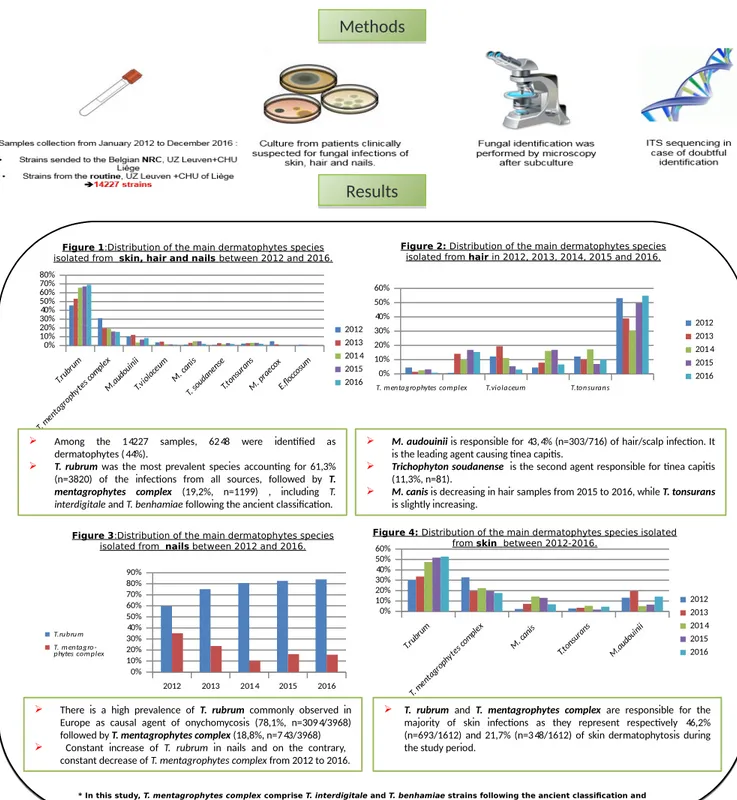The Belgian National Reference Center for Mycosis conducted a survey on dermatophytes strains circulating from 2012 to 2016. The present study was performed to assess the profile of dermatophytosis and to identify the species involved.
Objectives
Objectives
Methods
Methods
Conclusion
Conclusion
Sacheli Rosalie1,2, Darfouf Rajae1,2, Adjetey Caroline2,Pateet Sofie3 , Lagrou Katrien3
, Hayette Marie-Pierre1,2.
1National Reference Center for Mycosis, 2Department of Clinical Microbiology, Center for Interdisciplinary Research on Medecines, University Hospital of Liège Belgium 3 Department of Microbiology and Immunology, University Hospitals Leuven, Belgium.
Corresponding author
r.sacheli@chu.ulg.ac.be
P155
A 5-year survey of dermatophytosis in
Belgium
Our study confirms the predominance of T. rubrum followed by species from the ancient T. mentagrophytes complex (T. interdigitale + T.
benhamiae) in the Belgian population but also highlights the high prevalence of anthropophilic species such as M. audouinii and T. soudanense as causative agents of tinea capitis in children in relation with African immigration.
Results
Results
Figure 1:Distribution of the main dermatophytes species
isolated from skin, hair and nails between 2012 and 2016.
Figure 2: Distribution of the main dermatophytes species isolated from hair in 2012, 2013, 2014, 2015 and 2016.
Figure 3:Distribution of the main dermatophytes species isolated from nails between 2012 and 2016. 0% 10% 20% 30% 40% 50% 60% 70% 80% 2012 2013 2014 2015 2016
T. m en tagrophytes com plex T.violaceum T.ton surans
0% 10% 20% 30% 40% 50% 60% 2012 2013 2014 2015 2016 2012 2013 2014 2015 2016 0% 10% 20% 30% 40% 50% 60% 70% 80% 90% T.rubru m T. m entagro -phytes com plex
0% 10% 20% 30% 40% 50% 60% 2012 2013 2014 2015 2016 Figure 4: Distribution of the main dermatophytes species isolated
from skin between 2012-2016.
Among the 14227 samples, 6248 were identified as dermatophytes (44%).
T. rubrum was the most prevalent species accounting for 61,3% (n=3820) of the infections from all sources, followed by T. mentagrophytes complex (19,2%, n=1199) , including T.
interdigitale and T. benhamiae following the ancient classification.
M. audouinii is responsible for 43,4% (n=303/716) of hair/scalp infection. It is the leading agent causing tinea capitis.
Trichophyton soudanense is the second agent responsible for tinea capitis (11,3%, n=81).
M. canis is decreasing in hair samples from 2015 to 2016, while T. tonsurans is slightly increasing.
There is a high prevalence of T. rubrum commonly observed in Europe as causal agent of onychomycosis (78,1%, n=3094/3968) followed by T. mentagrophytes complex (18,8%, n=743/3968)
Constant increase of T. rubrum in nails and on the contrary, constant decrease of T. mentagrophytes complex from 2012 to 2016.
T. rubrum and T. mentagrophytes complex are responsible for the majority of skin infections as they represent respectively 46,2% (n=693/1612) and 21,7% (n=348/1612) of skin dermatophytosis during the study period.
* In this study, T. mentagrophytes complex comprise T. interdigitale and T. benhamiae strains following the ancient classification and does not take into account the new classification defined by de Hoog in 2016.
